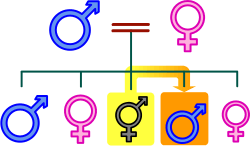Definify.com
Definition 2025
弟
弟
Translingual
Han character
| Stroke order | |||
|---|---|---|---|
| | |||
弟 (radical 57 弓+4, 7 strokes, cangjie input 金弓中竹 (CNLH), four-corner 80227, composition ⿹丿弚)
Derived characters
References
- KangXi: page 357, character 17
- Dai Kanwa Jiten: character 9737
- Dae Jaweon: page 673, character 19
- Hanyu Da Zidian: volume 1, page 244, character 10
- Unihan data for U+5F1F
Chinese
|
simp. and trad. |
弟 | |
|---|---|---|
Glyph origin
| Characters in the same phonetic series (弟) (Zhengzhang, 2003) | |
|---|---|
| Old Chinese | |
| 梯 | *tʰiːl |
| 睇 | *tʰiːl, *diːls |
| 涕 | *tʰiːlʔ, *tʰiːls |
| 挮 | *tʰiːlʔ |
| 鬀 | *tʰiːls, *diːls |
| 剃 | *tʰiːls |
| 綈 | *diːl |
| 蕛 | *diːl |
| 稊 | *diːl |
| 苐 | *diːl |
| 鵜 | *diːl |
| 銻 | *diːl |
| 鮷 | *diːl |
| 罤 | *diːl |
| 弟 | *diːlʔ, *diːls |
| 娣 | *diːlʔ, *diːls |
| 悌 | *diːlʔ, *diːls |
| 第 | *diːls |
Pronunciation
- Mandarin
- Cantonese (Jyutping): dai6, tai5
- Hakka (Sixian, PFS): thi
- Min Dong (BUC): dâ̤ / diê
- Min Nan (POJ): tī / tē
- Wu (Wiktionary): di (T3)
- Mandarin
- (Standard Chinese, Beijing)+
- Pinyin:
- Zhuyin: ㄉㄧˋ
- Wade-Giles: tih4
- Gwoyeu Romatzyh: dih
- IPA (key): /ti⁵¹/
- (Standard Chinese, Beijing)+
- Cantonese
- (Standard Cantonese, Guangzhou)+
- Jyutping: dai6, tai5
- Yale: daih, táih
- Cantonese Pinyin: dai6, tai5
- IPA (key): /tɐi̯²²/, /tʰɐi̯¹³/
- (Standard Cantonese, Guangzhou)+
- Hakka
- (Sixian, incl. Miaoli and Meinong)
- Pha̍k-fa-sṳ: thi
- Hakka Romanization System: ti
- Hagfa Pinyim: ti4
- IPA: /tʰi⁵⁵/
- (Sixian, incl. Miaoli and Meinong)
- Min Dong
- (Fuzhou)
- Bàng-uâ-cê: dâ̤ / diê
- IPA (key): /tɑ²⁴²/, /tiɛ²⁴²/
- (Fuzhou)
- Min Nan
- Wu
- (Shanghainese)
- Wiktionary: di (T3)
- IPA (key): /d̻i²³/
- (Shanghainese)
| Rime | ||
|---|---|---|
| Character | 弟 | 弟 |
| Reading # | 1/2 | 2/2 |
| Initial (聲) | 定 (7) | 定 (7) |
| Final (韻) | 齊 (39) | 齊 (39) |
| Tone (調) | Rising (X) | Departing (H) |
| Openness (開合) | Open | Open |
| Division (等) | IV | IV |
| Fanqie | 徒禮切 | 特計切 |
| Reconstructions | ||
| Zhengzhang Shangfang |
/deiX/ | /deiH/ |
| Pan Wuyun |
/deiX/ | /deiH/ |
| Shao Rongfen |
/dɛiX/ | /dɛiH/ |
| Edwin Pulleyblank |
/dɛjX/ | /dɛjH/ |
| Li Rong |
/deiX/ | /deiH/ |
| Wang Li |
/dieiX/ | /dieiH/ |
| Bernard Karlgren |
/dʱieiX/ | /dʱieiH/ |
| Expected Mandarin Reflex |
dì | dì |
| Baxter-Sagart system 1.1 (2014) | |
|---|---|
| Character | 弟 |
| Reading # | 1/1 |
| Modern Beijing (Pinyin) |
dì |
| Middle Chinese |
‹ dejX › |
| Old Chinese |
/*lˤəjʔ/ |
| English | younger brother |
Notes for Old Chinese notations in the Baxter-Sagart system: * Parentheses "()" indicate uncertain presence; | |
| Zhengzhang system (2003) | ||
|---|---|---|
| Character | 弟 | 弟 |
| Reading # | 1/2 | 2/2 |
| No. | 2294 | 2297 |
| Phonetic component |
弟 | 弟 |
| Rime group |
脂 | 脂 |
| Rime subdivision |
1 | 1 |
| Corresponding MC rime |
弟 | 第 |
| Old Chinese |
/*diːlʔ/ | /*diːls/ |
| Notes | 甲金文象繩束弋(朱芳圃說),繞弋繩須次第不亂方利於射,爲第初文 | |
Definitions
弟
Compounds
References
- “Entry #3144”, in 臺灣閩南語常用詞辭典 [Dictionary of Frequently-Used Taiwan Minnan] (in Chinese and Min Nan), Ministry of Education, R.O.C., 2011.
Japanese
Kanji
Readings
Etymology 1
| Kanji in this term |
|---|
| 弟 |
|
おと Grade: 2 |
| kun'yomi |
Cognate with the verb 劣る (otoru, “to be lesser, inferior”).[1]
Pronunciation
Alternative forms
Noun
See also
- 劣る (otoru)
Etymology 2
| Kanji in this term |
|---|
| 弟 |
|
おとうと Grade: 2 |
| kun'yomi |
/otopito/ → /otoɸito/ → /otowito/ → /*otowuto/ → /otouto/ → /otoːto/
Originally a compound of 弟 (oto, “younger sibling”) + 人 (hito, “person”).[1][2]
Pronunciation
Noun
弟 (hiragana おとうと, romaji otōto)
Usage notes
Used when referring to one’s own younger brother. To refer to someone else’s younger brother, the suffixed form 弟さん (otōto-san) is used instead. When addressing one’s own younger brother, the given name is used, often with a suffix, such as 太郎君 (Tarō-kun). Contrast with addressing one’s own older brother, when one uses the honorific お兄さん (onīsan).
References
- 1 2 1988, 国語大辞典(新装版) (Kokugo Dai Jiten, Revised Edition) (in Japanese), Tōkyō: Shogakukan
- 1 2 2006, 大辞林 (Daijirin), Third Edition (in Japanese), Tōkyō: Sanseidō, ISBN 4-385-13905-9
- ↑ 1998, NHK日本語発音アクセント辞典 (NHK Japanese Pronunciation Accent Dictionary) (in Japanese), Tōkyō: NHK, ISBN 978-4-14-011112-3
